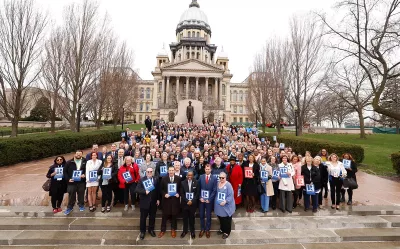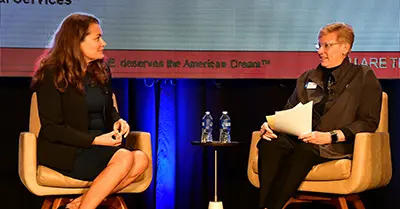On International Women’s Day (March 8), Illinois REALTORS® salutes past and present female leaders in the state association and wants to encourage women of all backgrounds who want to become future leaders of our association.
Leadership skills can be honed informally when more experienced members mentor newcomers. Or they can be developed in a more formal environment when members take training and accept greater responsibilities in their local, state and national REALTOR® associations. Since 1938, the Women’s Council of REALTORS® has provided a place for female REALTORS® to hone their skills, especially when opportunities weren’t available elsewhere.
Women demonstrated their leadership skills in our state association, too
Since Illinois REALTORS®’ creation in 1916, countless women have served as members of our board of directors and as committee chairs. In fact, 12 women have served as our president:
- Kathryn Duncan (1970),
- Lydia Franz (1984),
- Janet Andreotti (1995),
- Carol Shields (1996),
- Jean Crosby (1999),
- Judie McConville (2000),
- Colleen Clavesilla (2001),
- Toni Sherman (2003),
- Kay Wirth (2008),
- Sheryl Grider Whitehurst (2011),
- Loretta Alonzo-Deubel (2012) and
- Sue Miller (2021).
Key women leaders in 2022
In 2022, numerous women serve the state association through several noteworthy positions. For example, the Illinois REALTORS® Board of Directors includes: Ayn Bartok, Teresa Camarato, Linda Dressler, Carrie J. Little, Sue Miller, Nykea Pippion McGriff, Debbie Prodehl, Tracey Royal, Ginger Sreenan, Nancy Suvarnamani and Rebecca Thomson. Female committee chairs include:
- Sonia Anaya (RPAC Fundraising Working Group),
- Amy Barnes (REEF Board of Directors),
- Shaunta Gray (Affordable Housing and Community Involvement Committee),
- Alessandra Halliburton (Commercial and Property Management Committee),
- Carrie J. Little (Leadership Development Working Group),
- Antonia Mills (REALTORS® Political Involvement Working Group),
- Karen Parent (Grievance Committee),
- Debbie Pawlowicz (Illinois Local Government IE Committee) and
- Connie Vavra (YPN Advisory Group).
Today’s female leaders owe a debt to their predecessors
About 80 years ago, the Women’s Council began offering opportunities for women. But did you know that changing public perceptions of women in the work place started almost 100 years before that?
In the decades prior to the Civil War, groups advocated for women’s rights, including the right to vote. In 1848, abolitionist activists, led by Elizabeth Cady Stanton and Lucretia Mott, met in Seneca Falls, New York to discuss women’s rights and developed the Declaration of Sentiments: “We hold these truths to be self-evident. That all men and women are created equal, that they are endowed by their creator with certain inalienable rights, that among these are life, liberty and the pursuit of happiness.”
Although the Civil War delayed the momentum of the movement, once the war ended, the United States passed several amendments to the U.S. Constitution that revolved around citizenship and human rights. The 13th Amendment (ratified in 1865) outlawed slavery, the 14th Amendment (1868) gave citizenship to all persons born or naturalized in the U.S., and the 15th Amendment (1870) protected the voting rights of Americans regardless of “race, color or previous condition of servitude.” The women’s movement eventually regained its momentum, and in 1911, International Women’s Day was recognized in the United States. Within the next decade, women gained the right to vote with the 19th Amendment to the U.S. Constitution (1920).
History of International Women’s Day
Since its creation, International Women’s Day has celebrated the social, economic, cultural and political achievements of women, raised money for female-focused charities and renewed the call for improving gender parity.
The history of International Women’s Day coincides with activism in the United States and Europe in the early 1900s, according to internationalwomensday.com. The website provides a timeline of noteworthy women’s achievements, starting with the 1908 women’s march in New York City when about 15,000 women took to the streets to demand shorter working hours, better pay and voting rights.
The following year, the first National Women’s Day was observed on Feb. 28 in the United States. Women there continued to observe National Women’s Day on the last Sunday of February for several years. In 1911, more than a million women and men in Austria, Denmark, Germany and Switzerland rallied to end discrimination, improve worker rights, establish voting rights and receive training for public office. Read more from the International Women’s Day timeline.




 Create professional development programs that help REALTORS® strengthen their businesses.
Create professional development programs that help REALTORS® strengthen their businesses.
 Protect private property rights and promote the value of REALTORS®.
Protect private property rights and promote the value of REALTORS®.
 Advance ethics enforcement programs that increase REALTOR® professionalism.
Advance ethics enforcement programs that increase REALTOR® professionalism.
 Protect REALTORS® by providing legal guidance and education.
Protect REALTORS® by providing legal guidance and education. Stay current on industry issues with daily news from Illinois REALTORS®, network with other professionals, attend a seminar, and keep up with industry trends through events throughout the year.
Stay current on industry issues with daily news from Illinois REALTORS®, network with other professionals, attend a seminar, and keep up with industry trends through events throughout the year.






